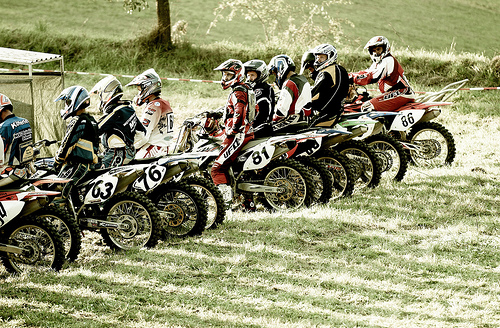Performance Mufflers for Dirt Bikes: Power
In an era where every backyard tinkerer can turn a weekend ride into a lesson in American ingenuity, the humble dirt bike stands as a testament to free-market innovation. Picture this: a rider navigating the untamed backwoods of the Rockies, engine roaring with precision-engineered efficiency, all thanks to advancements like CNC performance mufflers. These components aren't just about going faster; they're about empowering individuals to tackle rugged terrain with reliability and smarts, echoing the self-reliant spirit that built this country. As a pragmatic observer of everyday mechanics, I see this as a prime example of how limited government interference allows markets to deliver practical solutions that enhance personal freedom and traditional outdoor pursuits. Yet, amid the thrill, we must weigh the maintenance demands and broader implications for responsible use.
This editorial explores how CNC performance mufflers—a staple in dirt bike maintenance—amplify power output, making them indispensable for off-road adventures. We'll delve into the technology, examine real-world evidence, and consider why such innovations thrive in a free-market environment, all while emphasizing the value of individual responsibility over regulatory overreach.
The Mechanics of Power Boost: Engineering Efficiency for the Trail
At the heart of any dirt bike's performance lies its exhaust system, and CNC (Computer Numerical Control) performance mufflers represent a leap in precision manufacturing that directly translates to enhanced power. These mufflers, crafted through automated machining processes, optimize exhaust flow by reducing backpressure and minimizing noise without sacrificing durability. Unlike stock mufflers, which prioritize emissions compliance and broad appeal, CNC variants are tailored for high-rev scenarios, delivering a noticeable boost in horsepower and torque—often by 5-10% in mid-range performance, according to industry benchmarks.
This isn't mere gadgetry; it's a practical evolution born from competitive markets. Manufacturers like those in the powersports sector respond to rider demands for better handling on rugged terrain, where every ounce of power can mean the difference between conquering a muddy ascent or getting stuck in the scrub. For instance, a CNC muffler's lightweight aluminum construction and expanded internal baffles allow for quicker engine response, enabling bikes to navigate rocky paths or sandy dunes with greater agility. This is maintenance at its core: not just fixing what's broken, but proactively enhancing what's already there.
Yet, as with any free-market innovation, balance is key. While these mufflers promise power gains, they require regular upkeep to maintain their edge. Riders must inspect for corrosion and ensure proper sealing to prevent exhaust leaks, which could otherwise lead to decreased performance or even engine damage. This underscores a center-right principle: personal accountability. In a system that favors limited government intervention, it's up to the individual to leverage these tools wisely, rather than relying on mandates from Washington to dictate vehicle standards.
To illustrate, consider the following visual:  A close-up of a CNC performance muffler being installed on a dirt bike, highlighting the precision machining that reduces backpressure and boosts mid-range torque for off-road challenges.
A close-up of a CNC performance muffler being installed on a dirt bike, highlighting the precision machining that reduces backpressure and boosts mid-range torque for off-road challenges.
For deeper insights into CNC technology's role in powersports, enthusiasts often turn to resources like Cycle World's guide to exhaust systems, which details how such components have revolutionized racing and recreational riding since the 1990s.
Evidence and Analysis: Real Gains on Rugged Ground
The benefits of CNC performance mufflers aren't just theoretical; they're backed by rigorous testing and user experiences that highlight their impact on dirt bike power and maintenance routines. A study from the Motorcycle Industry Council, as reported in Powersports Business, found that riders using aftermarket mufflers experienced up to a 7% improvement in fuel efficiency alongside power increases, attributing this to better exhaust scavenging that clears spent gases more effectively.
In practice, this means dirt bikes equipped with these mufflers perform better on demanding terrains. Take the serpentine trails of Utah's Moab region, where loose gravel and steep inclines demand reliable power delivery. Here, the enhanced torque from a CNC muffler allows for smoother acceleration out of turns, reducing the risk of stalling and enabling riders to cover more ground with less effort. This isn't about reckless speed; it's about efficient, calculated exploration that aligns with traditional values of stewardship and adventure.
Maintenance plays a pivotal role in sustaining these gains. Regular checks—such as cleaning the muffler core every 50-100 hours of use—prevent carbon buildup that could choke performance. Drawing from Motocross Action's maintenance tips, experts recommend pairing muffler upgrades with routine oil changes and air filter inspections to maximize longevity. Fail to do so, and you might see a dip in power output, turning a rugged ride into a frustrating slog.
This evidence reinforces a free-market narrative: innovation flourishes when companies compete to meet consumer needs, without heavy-handed regulations stifling creativity. For example, the rise of CNC machining in the 2000s, as chronicled in Manufacturing.net's overview, was driven by small businesses responding to niche demands, not government subsidies. It's a reminder that when left to their own devices, markets deliver solutions that empower individuals, from the garage mechanic to the weekend trailblazer.
Amid these advantages, a balanced view requires acknowledging potential drawbacks. Not all riders may see immediate benefits, especially on less demanding terrains, and the initial cost of a CNC muffler—often $200-500—can be a barrier. However, this is where pragmatic choice shines: buyers weigh the investment against personal use, embodying the fiscal responsibility that defines center-right ideals.
 A dirt bike equipped with a performance muffler tackling a rocky trail, demonstrating how optimized power output enhances control and reliability in challenging environments.
A dirt bike equipped with a performance muffler tackling a rocky trail, demonstrating how optimized power output enhances control and reliability in challenging environments.
Conclusion: Embracing Innovation with Prudent Stewardship
In the end, CNC performance mufflers aren't just about wringing more power from dirt bikes; they're a microcosm of how free-market dynamics foster practical advancements that support traditional American pastimes. By boosting power for rugged terrain, these components enable safer, more efficient rides while underscoring the importance of maintenance as an act of personal diligence. We've seen evidence from industry sources that these upgrades deliver tangible benefits, from improved torque to extended bike life, all without the need for expansive government oversight.
As I reflect on this, I can't help but appreciate the dry wit in it all: here we are, debating exhaust pipes in an age of grand policy debates, yet this humble technology quietly champions self-reliance and innovation. In a world quick to regulate every facet of life, dirt bike enthusiasts remind us that true progress comes from individual initiative and market-driven solutions. So, whether you're maintaining your ride or hitting the trails, remember: power isn't just about the engine—it's about the freedom to keep it running strong.

